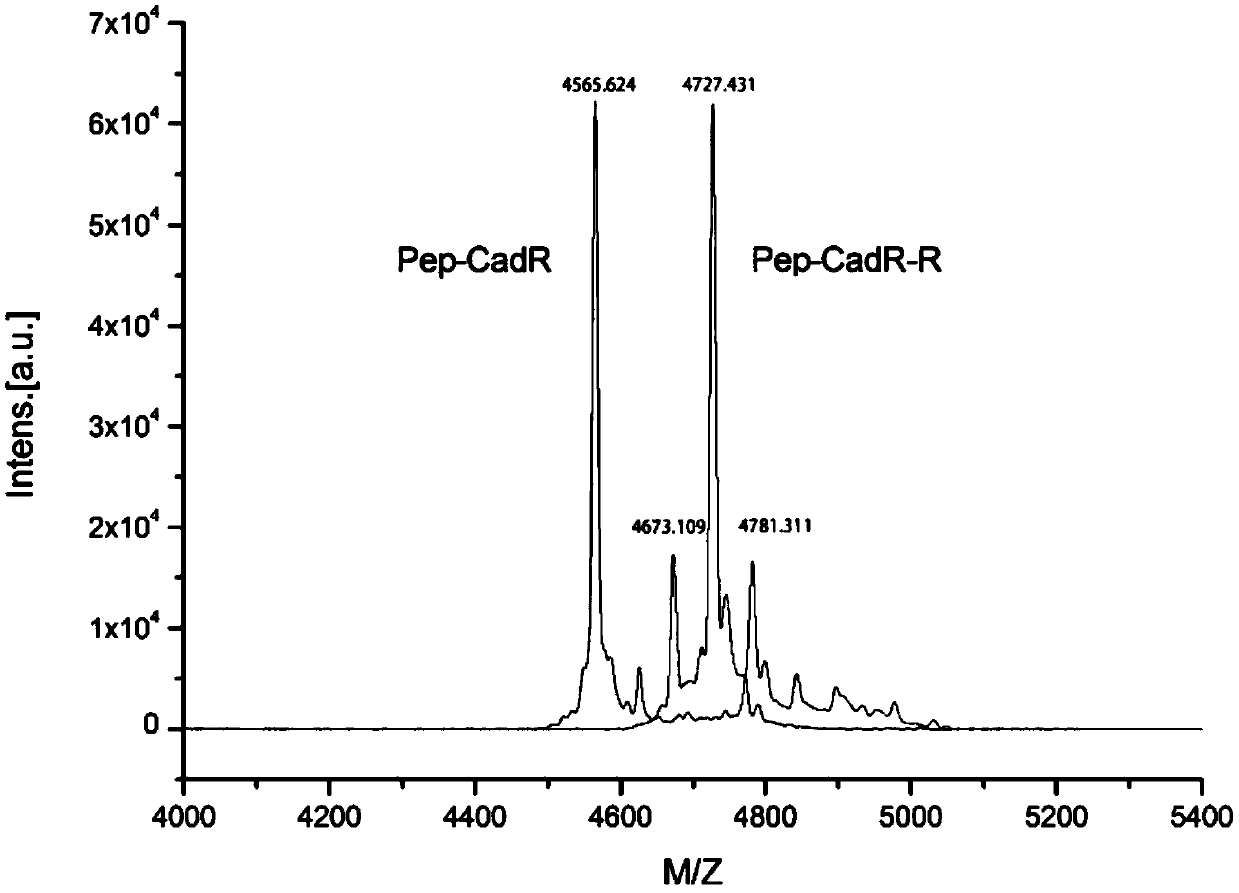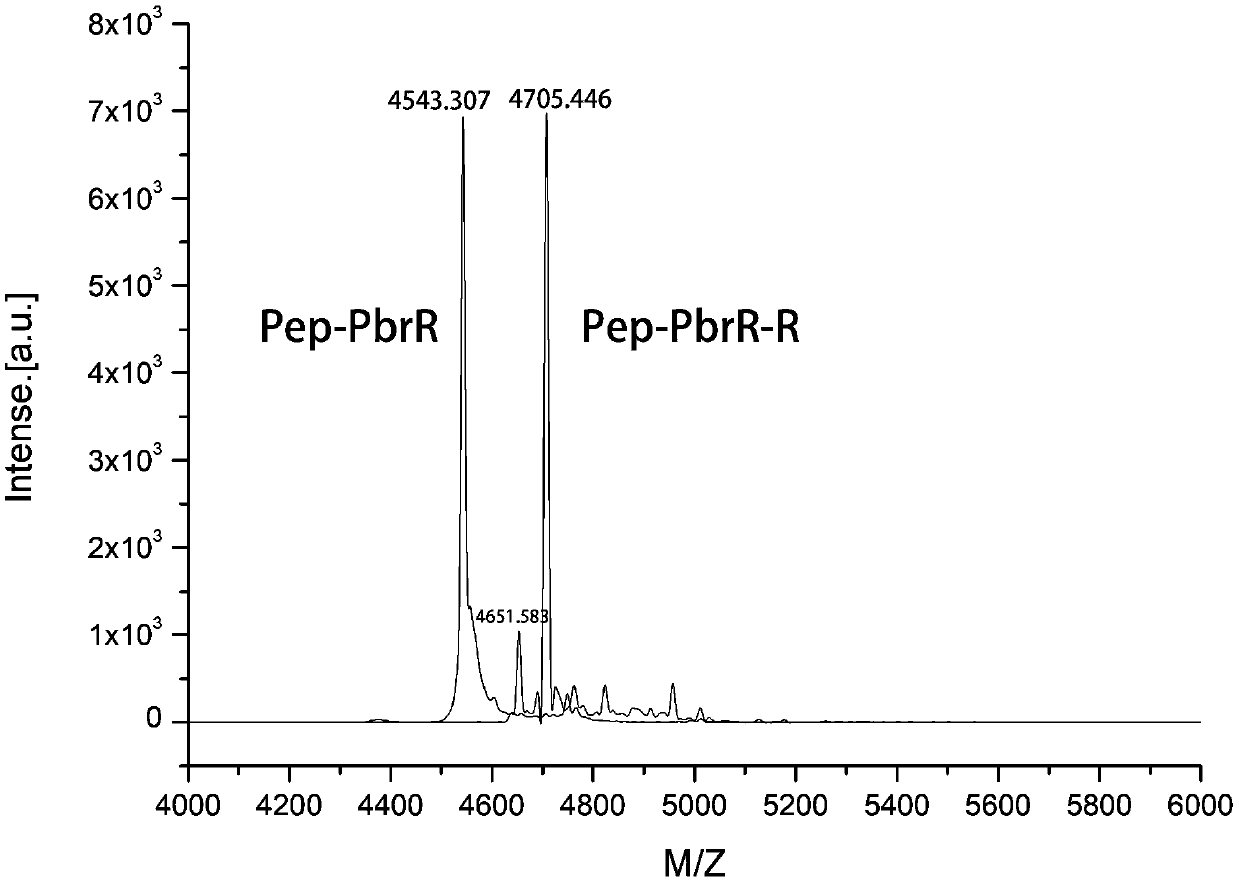Environment sensitive gel crosslinked with metalloprotein, and applications thereof
A metalloprotein and sensitive technology, applied in the direction of alkali metal compounds, alkali metal oxides/hydroxides, and other chemical processes, can solve the problems of poor metal selectivity and low sensitivity
- Summary
- Abstract
- Description
- Claims
- Application Information
AI Technical Summary
Problems solved by technology
Method used
Image
Examples
Embodiment 1
[0058] 1. The modified cadmium ion regulatory protein CadR of the present invention can be expressed, purified and modified using the following methods:
[0059] (1) Transform the pet28a plasmid encoding the modified cadmium ion regulatory protein obtained by total gene synthesis into E.coli BL21(DE3), induce expression with 0.5mM IPTG at 37°C for 4h, and collect the bacteria in a high-speed centrifuge. Store at -80°C until use. Use 30mL buffer to resuspend and ultrasonically lyse (buffer is 20mM Tris-HCl, pH 6.8, 100mMNaCl, 5mM 2-mercaptoethanol (β-ME), 1mM PMSF, 10% glycerol), and centrifuge the lysate at 15,000 rpm in a high-speed centrifuge , use a 0.45 μm filter membrane to filter the supernatant, and then load the sample onto a 5 mL nickel column. After equilibrating with 10% buffer B, use 10%-100% buffer B to elute for 5 column volumes. After the collected samples were concentrated, the solution was replaced with buffer A using a desalting column, and then digested wit...
Embodiment 2
[0065] Dissolve 220mg of isopropylacrylamide monomer, 2.4mg of N,N-methylenebisacrylamide, 1mg of anhydrous sodium sulfite in 2ml of secondary water, stir magnetically for 10min under nitrogen protection, and add 300μL dropwise (4mg dissolved In 300 μL of secondary water) potassium persulfate as the initiator, under the protection of nitrogen, continue to stir magnetically for 1 min, add 1 mL (0.33 mg / mL) of the modified modified cadmium ion-regulated protein CadR, and in the nitrogen atmosphere at 20 ° C for about 20 min Converge to form a gel. Add secondary water and soak at room temperature for 12 hours to elute uncrosslinked monomers, let stand at 37°C for about 1 hour, and centrifuge at 8000 rpm for 5 minutes to remove uncrosslinked proteins. After soaking in secondary water for 4 hours at 37°C to reduce the volume, replace the secondary water with 10mM Bis-Tris (pH 7.0), elute with 0.1mM TCEP buffer for 3 times, and then desorb using a mixer at 4-25°C 48 hours, eluted w...
Embodiment 3
[0067] The gel 1 before and after the release of metal ions was nitrified with 6 mL of concentrated nitric acid, and the concentration of Cd ions was measured using inductively coupled plasma mass spectrometry (ICP-MS). The results showed that the total amount of Cd ions in the gel before metal release was 63.7 nmol, the total amount of Cd ions after desorption at 4°C was 0.25 nmol, and the total amount of Cd ions after desorption at 25°C was 0.32 nmol. It shows that 99.5% of the metals can be fully released by reducing the temperature to make the gel swell. The appearance of gel 1 before and after swelling is as follows: Figure 7 shown.
PUM
 Login to View More
Login to View More Abstract
Description
Claims
Application Information
 Login to View More
Login to View More - R&D
- Intellectual Property
- Life Sciences
- Materials
- Tech Scout
- Unparalleled Data Quality
- Higher Quality Content
- 60% Fewer Hallucinations
Browse by: Latest US Patents, China's latest patents, Technical Efficacy Thesaurus, Application Domain, Technology Topic, Popular Technical Reports.
© 2025 PatSnap. All rights reserved.Legal|Privacy policy|Modern Slavery Act Transparency Statement|Sitemap|About US| Contact US: help@patsnap.com



